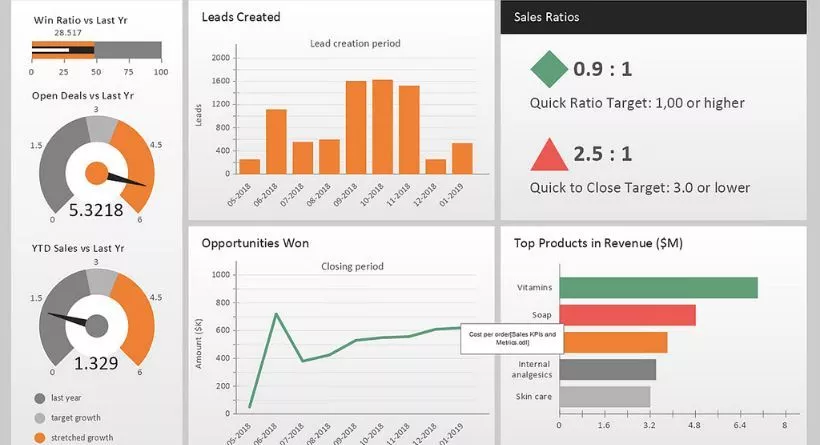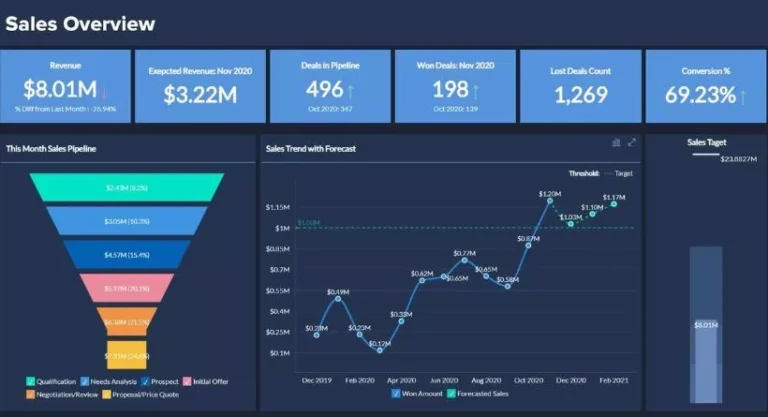If you’re a sales manager or a business owner, one problem that you’re likely quite familiar with is tracking your team’s performance. This issue may lead to a lack of transparency, miscommunication, and ineffective strategies. Accept it or not, we’re in the digital era, and relying on traditional techniques to assess sales performance can make things complicated and inefficient. But fear not – we’re here to give you a compelling solution: a well-structured sales dashboard.
In this blog post, we’re about to tackle the power of a sales dashboard and provide you with six practical examples to help you set up your own. A sales dashboard can be your trusty tool, your sword in the stone, so to speak. It can help you simplify tracking, understand data patterns, and ensure smooth communication in your team. That said, setting one up might feel like navigating through a labyrinth, especially if you’re doing it for the first time.
Understanding the Importance of a Sales Dashboard
First, let’s take a moment to clarify what a sales dashboard is. A sales dashboard is a practical tool that displays vital sales data. It’s represented in an easy-to-understand and interactive way, typically through graphs and charts. Like the dashboard in your car, it provides essential information at a glance to help you make informed decisions swiftly.
So, why is a sales dashboard critical? Imagine navigating a ship without a compass, or baking a cake without a recipe. You might reach your destination or end up with a delicious dessert, but it’s a risky and haphazard approach. The same applies to managing your sales process without a sales dashboard. It equips you with an overview of the team’s performance, customer behavior, sales figures, and much more. By giving you these insights, a sales dashboard serves as your compass, guiding you toward your sales goals with precision and understanding.
Essential Features of an Effective Sales Dashboard
Now that we’ve laid out why a sales dashboard is important, let’s dive into the elements that make it effective.
Real-Time Data Updates
First up is the ability to provide real-time data updates. In the fast-paced world of sales, staying current is vital. Your sales dashboard should be a live reflection of your business progress, allowing you to react promptly to any changes or developments. Picture it like a heart monitor in a hospital, continuously updating to show the patient’s current status.
Easy-to-Understand Visuals
Next, an effective sales dashboard needs to provide easy-to-understand visuals. Pie charts, bar graphs, or heat maps – whatever form it takes, the information should be digestible at a glance. After all, a picture paints a thousand words. It should serve as a visual storyteller, transforming complex data into a clear, comprehensive narrative.
Accessibility
Thirdly, accessibility is key. Your sales dashboard should be available wherever you are, be it your office, your home, or even on the go. Accessibility is about making it as simple as possible to tap into your sales data when you need it. Like having a reliable map on a long road trip, your sales dashboard should be available at your fingertips.
Customization
Lastly, customization is an integral feature of any effective sales dashboard. Every business is unique, with different metrics that matter. Your sales dashboard should reflect this uniqueness. It should allow you to tailor its features according to your specific needs and preferences. Think of it like your personal fitness plan; it should be customizable to your goals, preferences, and pace.
6 Sales Dashboard Examples that’ll Help You Set up Your Own
Setting up your own sales dashboard can feel like trying to build a house without a blueprint. That’s why we’ve gathered six practical examples to act as your guideposts.
1: Revenue Performance Dashboard
First, the Revenue Performance Dashboard. This type of sales dashboard gives a bird’s-eye view of your company’s revenue performance. It can track things like sales revenue, monthly recurring revenue, and year-over-year growth. Picture it as your company’s financial health monitor, continuously updating to keep you informed.
2: Sales Activity Dashboard
Second, consider the Sales Activity Dashboard. It tracks actions that lead to sales, such as calls made, emails sent, and meetings scheduled. It’s akin to your fitness tracker, monitoring every step and move that brings you closer to your sales goal.
3: Pipeline Overview Dashboard
Third is the Pipeline Overview Dashboard. This helps visualize your sales funnel, from prospect to paying customer. It’s like your GPS, guiding you through each stage of the sales journey and helping you understand where you need to focus your efforts.
4: Sales Leaderboard Dashboard
Fourth, the Sales Leaderboard Dashboard. This dashboard encourages friendly competition among your team by displaying individual or team performance rankings. Think of it as the scoreboard at a sports game, spurring motivation and boosting productivity.
5: Customer Insights Dashboard
Fifth, we have the Customer Insights Dashboard. It provides a window into your customer behavior, tracking metrics like customer acquisition cost and lifetime value. Consider it a window into your customers’ world, helping you understand their behaviors, needs, and desires.
6: Sales Forecast Dashboard
Lastly, the Sales Forecast Dashboard. It provides predictions about future sales based on historical data, aiding in decision-making and strategic planning. Think of it as your weather forecast, allowing you to anticipate and prepare for future sales conditions.
Also Read: How to Post a Job on LinkedIn in 8 Easy Steps
How to Create Your Sales Dashboard

Now, you might be wondering how to go about creating your own sales dashboard. It’s a three-step process: identifying key metrics, choosing the right sales dashboard tool, and setting up and customizing your dashboard.
Identifying Key Metrics
Firstly, it’s vital to identify the key metrics relevant to your business. These are the numbers that will populate your sales dashboard and drive your decisions. Think of it as choosing the ingredients for a recipe – each metric adds flavor and depth to your overall understanding of your sales performance.
Choosing the Right Sales Dashboard Tool
Next, you need to choose the right sales dashboard tool. Look for a tool that offers real-time data updates, easy-to-understand visuals, accessibility, and customization. This choice is akin to selecting the right vehicle for a journey – the right tool will make your trip toward achieving your sales goals smooth and enjoyable.
Setting Up and Customizing Your Dashboard
Finally, you’ll need to set up and customize your dashboard. Make sure it reflects the uniqueness of your business and the key metrics you’ve identified. Think of it as setting up your workspace – having everything organized and personalized will make your work more efficient and enjoyable.
Conclusion
Navigating the world of sales can sometimes feel like steering a ship through stormy waters. Yet, an effective sales dashboard can be your reliable compass, guiding you smoothly toward your destination. This practical tool not only offers real-time updates and easy-to-understand visuals but also ensures accessibility and customization tailored to your business.
As we’ve seen, there are several types of dashboards, such as the Revenue Performance Dashboard, Sales Activity Dashboard, Pipeline Overview Dashboard, Sales Leaderboard Dashboard, Customer Insights Dashboard, and Sales Forecast Dashboard. Choosing the right one depends on your unique needs and goals.
Creating your sales dashboard involves identifying your key metrics, selecting the right tool, and setting it up to reflect your business’s individuality. With this knowledge in hand, you’re well-equipped to set sail toward your sales goals.







